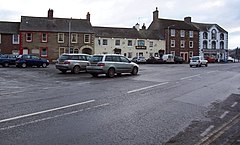|
Dalston, Cumbria
Dalston is a large village and civil parish in Cumbria, England, on the B5299 road 4 miles (6 km) south-west of Carlisle. The village is on the River Caldew, just to the north of where the Roe Beck joins it. Dalston railway station is on the Cumbrian Coast Line between Carlisle, Workington and Barrow-in-Furness. Historic buildings Rose Castle, home of the Bishop of Carlisle for many centuries until 2009, is within the parish of Dalston, 2.5 miles (4 km) south of the heart of the village. The architects Anthony Salvin and Thomas Rickman were responsible for the alterations which took place in the 19th century. Dalston Hall is a grade II* listed fortified house which is now a country house hotel.[2] Dalston has two churches: St Michael's Church and Dalston Methodist Church. GovernanceThere is a county electoral division of Dalston, stretching north towards Carlisle, with a total population at the 2011 United Kingdom census of 6,051.[3] EducationThere are two schools in Dalston, St. Michaels Primary School and Caldew Secondary School. EconomyThere is a Nestlé factory producing powdered milk, a BP fuel depot and the Barras Lane trading estate. Dalston Oil TerminalWith its location just outside Carlisle and near the M6 motorway, the Dalston Oil Terminal is a major distribution hub for fuels across the important Northern England supply corridor. Originally built in 1938 as a facility for the storage of aircraft fuel in the build-up to World War II, the terminal was expanded in the early 1960s by a joint venture between ShellMex and BP to include motor spirit tanks. Originally retained by BP following their 2005 divestment of the Innovene business, it was later purchased by Petroineos in 2010 to help support rail-borne exports from their Grangemouth Refinery. The terminal is fed directly from the Grangemouth Refinery via rail link, and delivers various product grades of petrol, diesel, fuel oil and kerosene to road customers. In late 2023 Petroineos announced that it would cease manufacturing operations at Grangemouth by 2025, to convert the refinery into a terminal for the import, storage and distribution of a range of fuels.[4] In September 2024, Petroineos further confirmed that the closure would result in the sale or closure of the Dalston Oil Terminal, with the final fuel shipment expected by the end of 2024.[5] Notable people
See alsoReferences
External linksWikimedia Commons has media related to Dalston.
|
||||||||||||||||||||||||||||||||||||||||||||


